Traditionalist Issues
 |
 |
 |
 |
 |
 |
 |
Dialogue Mass - CXVII
Turning the Old Pyramidal Power Structure
on Its Head
Nothing could be more illustrative of a complete revolution in the established system of government than the image of an inverted pyramid. First used at Vatican II by Bishop Emile de Smedt during the discussion process on the Church’s Constitution, it became the metaphor of choice among revolutionaries to indicate a total rupture with Tradition. He denounced the pyramidal system of government as a form of “clericalism” that placed the Pope at the apex wielding his supreme power of jurisdiction over the rest of the Church, with the “passive” laity occupying the base. (1)
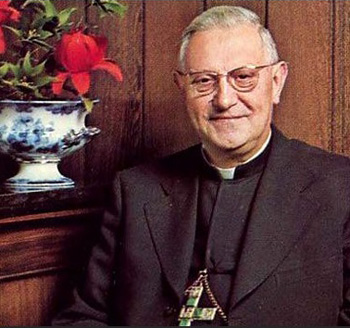 The metaphor was popularized by Card. Suenens, one of the four Moderators of the Council, who stated in a 1969 interview:
The metaphor was popularized by Card. Suenens, one of the four Moderators of the Council, who stated in a 1969 interview:
“The pyramid of the old manuals was reversed; one Roman prelate described it as a truly ‘Copernican’ Revolution.” (2)
The context of his remark was the decision among the progressivists at the Council to reject the original schema on the Constitution of the Church, which had given the Hierarchy (chap. 2) precedence over the laity (chap. 3). It is not generally known today that it was Bishop Wojtyla who proposed giving pride of place to the People of God by making them the subject of Chapter 2, while relegating the Hierarchy to a subservient role in Chapter 3. (3) Thus, simply by reversing the order of the chapters, they “flipped” the power pyramid upside down, so that the people at the base were instantly catapulted to the top, while the clergy became the “lowest of the low.”
Pope Francis confirmed this when he spoke of his vision of a Synodal Church in terms of “an inverted pyramid”:
“In this Church, as in an inverted pyramid, the top is located beneath the base.” (4)
A Church standing on its head
So, if all the priests, Bishops and even the Pope himself are placed below the people, what does this topsy-turvy image suggest about the place of Christ in His own Church? It makes it difficult to grasp the doctrine that Our Lord is Head of the Mystical Body when we see that the Pope – described by St. Catherine of Siena as “il dolce Cristo in terra” (Our Sweet Christ on Earth) – who formerly stood at the apex, is now at the absolute nadir.
Judging by the external, objective evidence alone, without straying into the inner dispositions of the soul, Pope Francis’s statement clearly shows that Christ, whose Vicar he is, does not rank as his highest priority.
The Constitution of the Church is substantially unalterable
Christ Himself gave His Church an essential organization – a Constitution composed, as Pope Pius X stated, of two unequal classes, the Hierarchy and the faithful who owe obedience to it. Whatever power and jurisdiction the Church has resides ultimately in the Hierarchy because it was granted to it by divine right and origin. Not even a Pope has any right to alter what Our Lord has incorporated as a necessary part of His Church. It follows that to contest this power structure with a view to replacing it by any other form of government is tantamount to attempting to change the Church herself.
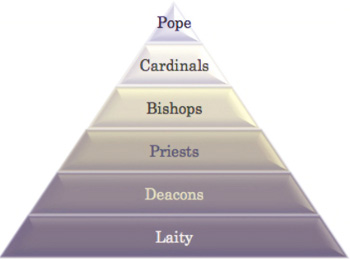 And yet this is exactly what some progressivist Bishops were calling for when they rejected the original schema on the Constitution of the Church because it referred to the laity as “subjects” of hierarchical power. Their spokesman, Bishop Emile de Smedt, redefined the Constitution as follows:
And yet this is exactly what some progressivist Bishops were calling for when they rejected the original schema on the Constitution of the Church because it referred to the laity as “subjects” of hierarchical power. Their spokesman, Bishop Emile de Smedt, redefined the Constitution as follows:
“In the People of God, we are all joined together as one and we all have the same fundamental rights and duties. We all participate in the royal priesthood of the People of God. The Pope is one of the faithful; we are all the faithful: bishops, priests, laity and religious.” (5)
Bishop de Smedt’s statement was a most effective act of subversion of the hierarchical nature of the Church. With this new all-are-equal ideology, the Church’s Constitution disappears into an amorphous mass of co-workers, all having been sent on a Mission for the benefit of the world. The underlying message is that there is nothing sacrosanct about the constitutional structure of the Church and that it is reversible.
There were plenty of voices during and after Vatican II insisting on “inverting the pyramid” – it was, after all, part of Pope John Paul II’s plan for renewal in the Church – and doing so lent kudos and importance to the institutions adopting the Vatican II party line, as well as advancement to individuals whose ecclesiastical careers depended on conformity to it.
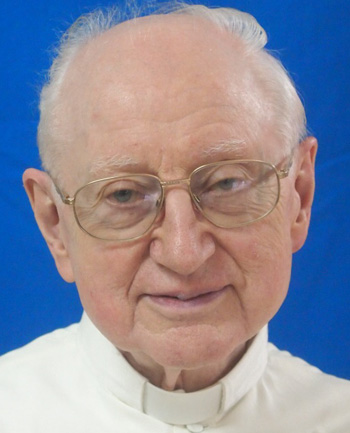 A prominent member of Opus Dei, Msgr. Cormac Burke, (6) who backed the Conciliar Revolution to the hilt, objected to the traditional Constitution, blaming its power structure as the cause of disorder in the Church:
A prominent member of Opus Dei, Msgr. Cormac Burke, (6) who backed the Conciliar Revolution to the hilt, objected to the traditional Constitution, blaming its power structure as the cause of disorder in the Church:
“There the real power is at the top and it is shared according to one’s place on the ladder up or down the pyramid. The laity are seen as on the lowest rung of the ladder, and reform or progress is understood as transfer of power, by means of a peaceful or forced ‘liberation’ of lay people from clerical domination, so that they too are free to work upwards to ‘controlling’ positions.” (7)
In other words, if there were no ranking system, there would be no power struggles. His solution to this fabricated problem:
“The ‘power-pyramid’ thinking needs to be totally abandoned, if necessary by giving a revolutionary turn to one’s whole outlook. In effect, if we want to represent roles in the Church graphically, we have to demolish the power-pyramid and trace instead a ‘service-pyramid.’ ”(8)
But elevation to position always comes from above – ironically in Msgr. Burke’s case from the very apex of the power-pyramid he condemned – for it was John Paul II who appointed him in 1986 as a judge on the Roman Rota, the Church’s highest judicial court, from where he copiously exercised his clerical power over the faithful for many years.
Institutional virtue-signalling
A notable feature of the “inverted pyramid” rhetoric was its inbuilt presumption that the pre-Vatican II clergy were guilty of pride in seeking to “pull rank” on the laity, whereas modern priests can congratulate themselves that they follow the example of Christ Who humbled Himself to wash His disciples’ feet. So in Msgr. Burke’s new “service pyramid,” Our Lord (together with His ministers) is placed at the bottom, below the laity:
“Christ our Lord has chosen for himself the lowest place, that of the servant of all... (we see this reflected in the traditional title of the Pope: ‘servant of the servants of God’).” (9)
A misunderstood title
But there is much confusion over the meaning of this paradoxical title which actually signifies that the Pope is the highest, not the lowest, of God’s servants. It derives from the “superlative” Latin phrase servus servorum Dei, (10) first used by St. Gregory the Great (Pope from 590 to 604) to indicate the supreme “Power of the Keys,” i.e., his universal jurisdiction over the Church. It was a title of pride not in himself but in Christ whose place he occupied as Head of the Mystical Body on earth.
His purpose in assuming the title was to counter rival claims by the Patriarchs of Constantinople who styled themselves “Universal” or “Ecumenical Patriarch.” In particular, he wanted to teach Patriarch John IV a lesson in humility: that he must submit to the supremacy of the Bishop of Rome who gave the example of serving all.
It is true that Pope Gregory the Great, who was noted for his great humility, called himself “the servant of all,” not in the sense of occupying the lowest position in the Church, as the reformers smugly claim, but in the sense of having to carry the overwhelmingly onerous burden of the papacy. (11) The crucial point is that he did so while exercising his spiritual and temporal power to the full. This shows that “clerical power” and “humble service” in the Church are not antithetical concepts, requiring the former to be eliminated or reduced to enable the latter. There was no need, therefore, to invert the pyramid.
The clergy are forced to eat humble pie
It is undeniable that, since Vatican II, the Hierarchy have been placed in a pecking order well below the laity, where they have become submissive and apologetic for ever having thought of themselves as higher than the laity. The inevitable effect of inverting the pyramid was artificially to inflate the importance of the laity at the expense of the Hierarchy. This is clear from the following frankly “triumphalist” statement by Card. Kevin Farrell who had been appointed by Pope Francis to the Head of the recently invented Dicastery for Laity, Family and Life:
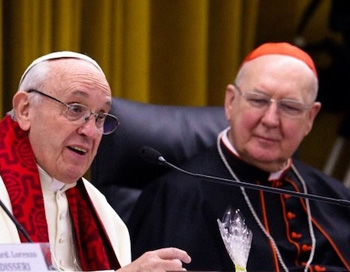 “Laity are the most important people in the Church ‒ not the clergy or bishops.” (12)
“Laity are the most important people in the Church ‒ not the clergy or bishops.” (12)
There is nothing new or surprising in this. It was, as we have seen above, precisely the “Copernican Revolution” aimed for by the progressivists at the Council when they gave precedence to the laity over the Hierarchy in the Dogmatic Constitution Lumen gentium. What is surprising, however, is how few people can see that the Council’s rhetoric about “equality” was so much smoke and mirrors. The Popes of the Council and Church leaders like Card. Farrell, faithful to the underlying meaning of Lumen gentium, have actually created their own two-tier constitutional system, a new “power-pyramid” replete with “top-dogs” and underdogs.
Papal supremacy, it seems, or rather a corrupted and heavily disguised form of it, lives on; in the hands of revolutionary Popes it is working to subvert the divinely-willed Constitution of the Church. This brings us to the subject of Clericalism, which will be treated in the next article.
Continued


Bishop Emile de Smedt, Belgium: The pyramidal structure of the Church must change
“The pyramid of the old manuals was reversed; one Roman prelate described it as a truly ‘Copernican’ Revolution.” (2)
The context of his remark was the decision among the progressivists at the Council to reject the original schema on the Constitution of the Church, which had given the Hierarchy (chap. 2) precedence over the laity (chap. 3). It is not generally known today that it was Bishop Wojtyla who proposed giving pride of place to the People of God by making them the subject of Chapter 2, while relegating the Hierarchy to a subservient role in Chapter 3. (3) Thus, simply by reversing the order of the chapters, they “flipped” the power pyramid upside down, so that the people at the base were instantly catapulted to the top, while the clergy became the “lowest of the low.”
Pope Francis confirmed this when he spoke of his vision of a Synodal Church in terms of “an inverted pyramid”:
“In this Church, as in an inverted pyramid, the top is located beneath the base.” (4)
A Church standing on its head
So, if all the priests, Bishops and even the Pope himself are placed below the people, what does this topsy-turvy image suggest about the place of Christ in His own Church? It makes it difficult to grasp the doctrine that Our Lord is Head of the Mystical Body when we see that the Pope – described by St. Catherine of Siena as “il dolce Cristo in terra” (Our Sweet Christ on Earth) – who formerly stood at the apex, is now at the absolute nadir.
Judging by the external, objective evidence alone, without straying into the inner dispositions of the soul, Pope Francis’s statement clearly shows that Christ, whose Vicar he is, does not rank as his highest priority.
The Constitution of the Church is substantially unalterable
Christ Himself gave His Church an essential organization – a Constitution composed, as Pope Pius X stated, of two unequal classes, the Hierarchy and the faithful who owe obedience to it. Whatever power and jurisdiction the Church has resides ultimately in the Hierarchy because it was granted to it by divine right and origin. Not even a Pope has any right to alter what Our Lord has incorporated as a necessary part of His Church. It follows that to contest this power structure with a view to replacing it by any other form of government is tantamount to attempting to change the Church herself.

No one can change the Hierarchical Structure of the Church - It is of Divine Institution
“In the People of God, we are all joined together as one and we all have the same fundamental rights and duties. We all participate in the royal priesthood of the People of God. The Pope is one of the faithful; we are all the faithful: bishops, priests, laity and religious.” (5)
Bishop de Smedt’s statement was a most effective act of subversion of the hierarchical nature of the Church. With this new all-are-equal ideology, the Church’s Constitution disappears into an amorphous mass of co-workers, all having been sent on a Mission for the benefit of the world. The underlying message is that there is nothing sacrosanct about the constitutional structure of the Church and that it is reversible.
There were plenty of voices during and after Vatican II insisting on “inverting the pyramid” – it was, after all, part of Pope John Paul II’s plan for renewal in the Church – and doing so lent kudos and importance to the institutions adopting the Vatican II party line, as well as advancement to individuals whose ecclesiastical careers depended on conformity to it.

Opus Dei Msgr. Cormac Burke was a full supporter of the Conciliar Revolution
“There the real power is at the top and it is shared according to one’s place on the ladder up or down the pyramid. The laity are seen as on the lowest rung of the ladder, and reform or progress is understood as transfer of power, by means of a peaceful or forced ‘liberation’ of lay people from clerical domination, so that they too are free to work upwards to ‘controlling’ positions.” (7)
In other words, if there were no ranking system, there would be no power struggles. His solution to this fabricated problem:
“The ‘power-pyramid’ thinking needs to be totally abandoned, if necessary by giving a revolutionary turn to one’s whole outlook. In effect, if we want to represent roles in the Church graphically, we have to demolish the power-pyramid and trace instead a ‘service-pyramid.’ ”(8)
But elevation to position always comes from above – ironically in Msgr. Burke’s case from the very apex of the power-pyramid he condemned – for it was John Paul II who appointed him in 1986 as a judge on the Roman Rota, the Church’s highest judicial court, from where he copiously exercised his clerical power over the faithful for many years.
Institutional virtue-signalling
A notable feature of the “inverted pyramid” rhetoric was its inbuilt presumption that the pre-Vatican II clergy were guilty of pride in seeking to “pull rank” on the laity, whereas modern priests can congratulate themselves that they follow the example of Christ Who humbled Himself to wash His disciples’ feet. So in Msgr. Burke’s new “service pyramid,” Our Lord (together with His ministers) is placed at the bottom, below the laity:
“Christ our Lord has chosen for himself the lowest place, that of the servant of all... (we see this reflected in the traditional title of the Pope: ‘servant of the servants of God’).” (9)
A misunderstood title
But there is much confusion over the meaning of this paradoxical title which actually signifies that the Pope is the highest, not the lowest, of God’s servants. It derives from the “superlative” Latin phrase servus servorum Dei, (10) first used by St. Gregory the Great (Pope from 590 to 604) to indicate the supreme “Power of the Keys,” i.e., his universal jurisdiction over the Church. It was a title of pride not in himself but in Christ whose place he occupied as Head of the Mystical Body on earth.
His purpose in assuming the title was to counter rival claims by the Patriarchs of Constantinople who styled themselves “Universal” or “Ecumenical Patriarch.” In particular, he wanted to teach Patriarch John IV a lesson in humility: that he must submit to the supremacy of the Bishop of Rome who gave the example of serving all.
It is true that Pope Gregory the Great, who was noted for his great humility, called himself “the servant of all,” not in the sense of occupying the lowest position in the Church, as the reformers smugly claim, but in the sense of having to carry the overwhelmingly onerous burden of the papacy. (11) The crucial point is that he did so while exercising his spiritual and temporal power to the full. This shows that “clerical power” and “humble service” in the Church are not antithetical concepts, requiring the former to be eliminated or reduced to enable the latter. There was no need, therefore, to invert the pyramid.
The clergy are forced to eat humble pie
It is undeniable that, since Vatican II, the Hierarchy have been placed in a pecking order well below the laity, where they have become submissive and apologetic for ever having thought of themselves as higher than the laity. The inevitable effect of inverting the pyramid was artificially to inflate the importance of the laity at the expense of the Hierarchy. This is clear from the following frankly “triumphalist” statement by Card. Kevin Farrell who had been appointed by Pope Francis to the Head of the recently invented Dicastery for Laity, Family and Life:

Francis raised Kevin Farrel to the Cardinalate, gave him the Dicastery for Laity & made him Camerlengo
There is nothing new or surprising in this. It was, as we have seen above, precisely the “Copernican Revolution” aimed for by the progressivists at the Council when they gave precedence to the laity over the Hierarchy in the Dogmatic Constitution Lumen gentium. What is surprising, however, is how few people can see that the Council’s rhetoric about “equality” was so much smoke and mirrors. The Popes of the Council and Church leaders like Card. Farrell, faithful to the underlying meaning of Lumen gentium, have actually created their own two-tier constitutional system, a new “power-pyramid” replete with “top-dogs” and underdogs.
Papal supremacy, it seems, or rather a corrupted and heavily disguised form of it, lives on; in the hands of revolutionary Popes it is working to subvert the divinely-willed Constitution of the Church. This brings us to the subject of Clericalism, which will be treated in the next article.
Continued
- E. De Smedt, Acta Synodalia Sacrosancti Concilii Oecumenici Vaticani II: Periodus prima, pars IV, 1 December 1962, p. 142: “Clericalismus: In primis schematis capitibus praevalet traditionalis pictura Ecclesiae. Cognoscitis pyramidem: papa, episcopi, sacerdotes, qui praesunt quique, potestatibus acceptis, docent, sanctificant, gubernant; dum, in basi, populus christianus magis receptive se habet, et quodam modo secundum locum videtur occupare in Ecclesia”. (Clericalism: In the first chapters of the [original] schema [on the constitution of the Church], the traditional image of the Church is brought to the fore. You all know the pyramid: the pope, bishops and priests who are the ones in command because they have received the power to teach, sanctify and rule; then, at the base, are the Christian people, where they are kept, relatively speaking, in a state of passivity, which is considered the place for them to occupy in the Church).
- L. Suenens, ‘Toward Unity and Freedom in the Church’, National Catholic Reporter, vol. 5, n. 31, May 28, 1969.
- Acta Synodalia, Session 2, Part 3, (Oct. 17-30, 1963), p. 154: “aptius videtur tractari de populo Dei in cap. II antequam de hierarchica Ecclesiae constitutione, seu episcopatu fit sermo…Quod concordat…sensui Evangeliorum, in quibus ‘praesse’ convenit cum ‘ministrare.’ ” (It seems more fitting to treat of the people of God in Chapter 2 before any mention is made of the hierarchical constitution of the Church, or of the episcopacy … because this is in concordance with the meaning of the Gospels, in which “being in authority” is linked with “being of service”).
- Pope Francis, Ceremony Commemorating the 50th Anniversary of the Institution of the Synod of Bishops, October 17, 2015.
- Acta Synodalia, Session 1, Part 4, December 1962: “In populo Dei, omnes sumus alii cum aliis coniuncti et eadem iura et officia fundamentalia habemus. Omnes participamus regali sacerdotio populi Dei. Papa est unus ex fidelibus; episcopi, sacerdotes, laici, religiosi, omnes sumus fideles.”
- Msgr. Burke was one of the founder members of Opus Dei in Ireland.
- Msgr. Cormac Burke, Opus Dei, ‘The freedom and responsibility of the laity’, Homiletic and Pastoral Review, July 1993, pp. 21-22.
- Ibid.
- Ibid.
- The Latin phrase is a direct translation from the Hebrew language, which uses a syntactical construct that places two nouns together – the second one called the “superlative genitive” – to express the highest degree or quality. We are familiar with this construct in the liturgy as, for instance, Rex regum et Dominus dominantium: King of Kings and Lord of Lords (the greatest of Kings and Lords), Canticum canticorum: Song of Songs (the most excellent of songs), or Virgo virginum: Virgin of Virgins (the purest of virgins). Even the expression saecula saeculorum (world without end) comes into this category to express what is beyond time, i.e., eternal life.
To clarify further, the Pope has also two other traditional titles based on the same Latin construction: Episcopus episcoporum (Bishop of Bishops, i.e., the highest Bishop) and Pastor pastorum (the Chief Shepherd). - Gregory I, Epistles, Book XI, Letter 44, to the noblewoman, Rusticiana: “per episcopatus onera servus sum omnium factus” (Through the burden of the episcopacy I have been made a servant of all).
- The Irish News, July 26, 2018. The Cardinal then went on to say that priests have no credibility in marriage preparation, and to show what Pope Francis is doing to promote the role of women.

Posted June 11, 2022
______________________
______________________
 Volume I |
 Volume II |
 Volume III |
 Volume IV |
 Volume V |
 Volume VI |
 Volume VII |
 Volume VIII |
 Volume IX |
 Volume X |
 Volume XI |
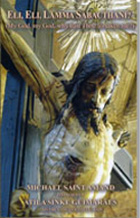 Special Edition |


